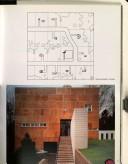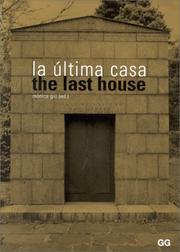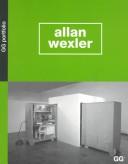| Listing 1 - 10 of 339 | << page >> |
Sort by
|

ISBN: 8425217334 9788425217333 Year: 1998 Publisher: Barcelona Editorial Gustavo Gili
Abstract | Keywords | Export | Availability | Bookmark
 Loading...
Loading...Choose an application
- Reference Manager
- EndNote
- RefWorks (Direct export to RefWorks)
This is the first monograph study of the German-born architect Simon Ungers (Cologne, 1957), who now lives and works in New York City.Simon Ungers' work can be divided into commissions, competitions and installations. The book brings together examples of all three categories, these ranging from built work such as the T-House in upstate New York to the latest schemes for international competitions, as well as a series of installations and sculptures shown in art galleries. These are different yet complementary fields of action which, taken together, offer a very complete vision of the paths and ideals in Simon Ungers' work.
architecture [discipline] --- Holocaust Memorial --- Architecture --- Ungers, Simon --- T-House --- anno 1900-1999 --- United States --- Architects --- Architecture, Modern --- Architectes --- Ungers, Simon, --- History --- Critique et interprétation --- Critique et interprétation --- museumarchitectuur --- United States of America

ISBN: 8425217342 9788425217340 Year: 1999 Publisher: Barcelona: Gustavo Gili,
Abstract | Keywords | Export | Availability | Bookmark
 Loading...
Loading...Choose an application
- Reference Manager
- EndNote
- RefWorks (Direct export to RefWorks)
726.8 --- Architecture, Modern --- -Sepulchral monuments --- Graftombes, ontworpen door o.a. A. Aalto, G. Asplund, M. Botta, W. Cuyvers, W. Gropius, H. Guimard, J. Hoffmann, V. Horta, A. Isozaki, R. Lalique, Le Corbusier, S. Lewerentz, A. Loos, Sir E. Lutyens, J. Llinàs, Ch. R. Mackintosh, J. Plecnik, A. Rossi, E. Saarinen, A. Sant'Elia, C. Scarpa, L. Sulli --- Grafmonumenten ; graftombes ; 20ste eeuw --- 726.82 --- Funeral monuments --- Funerary monuments --- Graves --- Gravestones --- Memorial tablets --- Tablets, Memorial --- Tombstones --- Monuments --- Modern architecture --- Funeraire architectuur. Gebouwen op begraafplaatsen --- Religieuze architectuur ; grafmonumenten --- Sepulchral monuments. --- Tombs. --- 726.8 Funeraire architectuur. Gebouwen op begraafplaatsen --- Sepulchral monuments --- Tombs --- Architecture --- History --- Art funéraire --- Cimetière --- Histoire de l'architecture --- Histoire de la sculpture
Book
ISBN: 9783110605822 3110605821 9783110609509 3110609509 3110609908 Year: 2019 Volume: 515 Publisher: Berlin ; Boston : De Gruyter,
Abstract | Keywords | Export | Availability | Bookmark
 Loading...
Loading...Choose an application
- Reference Manager
- EndNote
- RefWorks (Direct export to RefWorks)
According to narratives in the Bible the threats of the people's end come from various sources, but the most significant threat comes, as learned from the Pentateuch, from God himself. What is the theological meaning of this tradition? In what circumstances did it evolve? How did it stand alongside other theological and socio-political concepts known to the ancient authors and their diverse audience?The book employs a diachronic method that explores the stages of the tradition's formation and development, revealing the authors' exegetical purposes and ploys, and tracing the historical realities of their time.The book proposes that the motif of the threat of destruction existed in various forms prior to the creation of the stories recorded in the final text of the Pentateuch. The inclusion of the motif within specific literary contexts attenuated the concept of destruction by presenting it as a phenomenon of specific moments in the past. Nevertheless, the threat was resurrected repeatedly by various authors, for use as a precedent or a justification for present affliction.
God --- God (Judaism) --- Jews --- Genocide --- 22.08 --- 22.08 Bijbelse theologie --- 22.08 Theologie biblique --- Bijbelse theologie --- Theologie biblique --- Chosen people (Jews) --- Election of Israel --- Israel, Election of --- Election (Theology) --- Judaism --- People of God --- Wrath of God --- Anger --- Wrath --- History of doctrines --- Election, Doctrine of --- Religious aspects --- Chosen people --- Doctrine of election --- Mission --- Relations --- Attributes --- Bible. --- Antico Testamento --- Hebrew Bible --- Hebrew Scriptures --- Kitve-ḳodesh --- Miḳra --- Old Testament --- Palaia Diathēkē --- Pentateuch, Prophets, and Hagiographa --- Sean-Tiomna --- Stary Testament --- Tanakh --- Tawrāt --- Torah, Neviʼim, Ketuvim --- Torah, Neviʼim u-Khetuvim --- Velho Testamento --- Historiography. --- Biblical Historiography. --- Biblical Interpretation. --- Biblical Theology. --- Rewriting biblical traditions. --- Bible --- Theology.
Book
ISBN: 9783487146140 3487146142 Year: 2011 Publisher: Hildesheim : Georg Olms,
Abstract | Keywords | Export | Availability | Bookmark
 Loading...
Loading...Choose an application
- Reference Manager
- EndNote
- RefWorks (Direct export to RefWorks)
Logic, Ancient. --- Syllogism --- Logique ancienne --- Syllogisme --- History --- Histoire --- Alexander, --- Aristotle. --- Logic, Ancient --- Ancient logic

ISBN: 8425217539 Year: 1998 Publisher: Barcelona Gustavo Gili
Abstract | Keywords | Export | Availability | Bookmark
 Loading...
Loading...Choose an application
- Reference Manager
- EndNote
- RefWorks (Direct export to RefWorks)
Allan Wexler (° 1949, Bridgeport, Connecticut, VS) --- Allan Wexler (°1949, Bridgeport, Connecticut, USA) --- Architectuur ; interieurarchitectuur ; 1973-1997 ; A. Wexler --- Architectuur ; kleine gebouwen --- Compacte woningen --- 749.07 --- 749.038 --- Meubelontwerpers ; designers ; interieurarchitecten --- Meubelkunst en design ; 1950 - 2000 --- Architecture --- architecture [discipline] --- interior design --- interior decoration --- Wexler, Allan --- anno 1900-1999 --- United States --- United States of America
Book
ISBN: 9780472054282 0472054287 9780472074280 0472074288 9780472126088 0472126083 Year: 2019 Publisher: Ann Arbor, Mich. University of Michigan Press
Abstract | Keywords | Export | Availability | Bookmark
 Loading...
Loading...Choose an application
- Reference Manager
- EndNote
- RefWorks (Direct export to RefWorks)
"Modern Western culture is saturated with images, imprinting visual standards of concepts such as beauty and femininity onto our collective consciousness. Blindness Through the Looking Glass examines how gender and femininity are performed and experienced in everyday life by women who do not rely on sight as their dominant mode of perception, identifying the multiple senses involved in the formation of gender identity within social interactions. Challenging visuality as the dominant mode to understand gender, social performance, and visual culture, the book offers an ethnographic investigation of blindness (and sight) as a human condition, putting both blindness and vision 'on display,' discussing people's auditory, tactile, and olfactory experiences, as well as vision and sight, and exploring ways individuals perform blindness and 'sightedness' in their everyday lives. Based on in-depth interviews with 40 blind women in Israel and anthropological fieldwork, the book investigates the social construction and daily experience of blindness in a range of domains. Uniquely, the book brings together blind symbolism with the everyday experiences of blind and sighted individuals, joining in mutual conversation the fields of disability studies, visual culture, anthropology of the senses, and gender studies"--
Blind women --- #SBIB:39A9 --- #SBIB:316.334.3M20 --- Blindness in women --- Women with disabilities --- Social conditions --- Medische antropologie / gezondheid / handicaps --- Sociale epidemiologie en etiologie: sociale aspecten van ziekte en gezondheid --- Sociology of health --- Blindness --- Gender identity. --- Sex identity (Gender identity) --- Sexual identity (Gender identity) --- Identity (Psychology) --- Sex (Psychology) --- Queer theory --- Amaurosis --- Vision disorders --- Social aspects. --- Gender dysphoria --- Disability --- Gender --- Identity --- Relationships --- Attitudes --- Appearance --- Féminité
Book
ISBN: 3110609908 3110609509 9783110609905 9783110609509 9783110605822 3110605821 Year: 2019 Publisher: Berlin Boston
Abstract | Keywords | Export | Availability | Bookmark
 Loading...
Loading...Choose an application
- Reference Manager
- EndNote
- RefWorks (Direct export to RefWorks)
According to narratives in the Bible the threats of the people's end come from various sources, but the most significant threat comes, as learned from the Pentateuch, from God himself. What is the theological meaning of this tradition? In what circumstances did it evolve? How did it stand alongside other theological and socio-political concepts known to the ancient authors and their diverse audience?The book employs a diachronic method that explores the stages of the tradition's formation and development, revealing the authors' exegetical purposes and ploys, and tracing the historical realities of their time.The book proposes that the motif of the threat of destruction existed in various forms prior to the creation of the stories recorded in the final text of the Pentateuch. The inclusion of the motif within specific literary contexts attenuated the concept of destruction by presenting it as a phenomenon of specific moments in the past. Nevertheless, the threat was resurrected repeatedly by various authors, for use as a precedent or a justification for present affliction.
Book
ISBN: 8425220114 9788425220111 Year: 2005 Publisher: Barcelona : Editorial Gustavo Gili,
Abstract | Keywords | Export | Availability | Bookmark
 Loading...
Loading...Choose an application
- Reference Manager
- EndNote
- RefWorks (Direct export to RefWorks)
Jacobsen, Arne, --- Jacobsen, Arne --- Bâtiments publics --- 20e siècle --- Jacobsen, Arne (1902-1971)
Book
Year: 1992 Publisher: Milano : Electa,
Abstract | Keywords | Export | Availability | Bookmark
 Loading...
Loading...Choose an application
- Reference Manager
- EndNote
- RefWorks (Direct export to RefWorks)
Book
ISBN: 9788445139967 Year: 2022 Publisher: Madrid : Comunidad de Madrid : Ediciones Anómalas,
Abstract | Keywords | Export | Availability | Bookmark
 Loading...
Loading...Choose an application
- Reference Manager
- EndNote
- RefWorks (Direct export to RefWorks)
| Listing 1 - 10 of 339 | << page >> |
Sort by
|

 Search
Search Feedback
Feedback About UniCat
About UniCat  Help
Help News
News